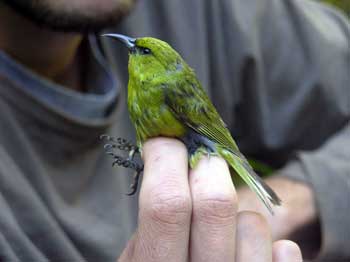
A native Hawaiian bird that has developed a resistance to disease has captured the attention of NAU scientist Jeff Foster.
Foster, a research associate in the Center for Microbial Genetics and Genomics at Northern Arizona University, is studying the amakihi, a Hawaiian songbird, for clues to why some of the species have evolved to resist avian malaria while others continue to develop it.
“The key goal has been to look for the evolution of resistance to the disease,” Foster said. “We hope that by understanding disease genetics, we can help develop long-term strategies for preventing further native bird extinctions.”
He added that besides seeking clues that could help protect the amakihi as well as its ecosystems, the research also could reveal insight to disease resistance in all species, including humans.
“In a world where disease incidence may be increasing due to links with climate change, understanding how a species developed a resistance could help us understand how humans fight disease,” he said. “Our amakihi research suggests that resistance to the disease was likely there all along, rather than a recent mutation.”
Foster is one of numerous researchers working on the Biocomplexity Project-Introduced Avian Diseases in Hawaii, funded by the National Science Foundation. He began researching the amakihi as part of his postdoctoral work at the Smithsonian Institution prior to joining NAU in 2007.
He explained that researchers are interested in the bird’s evolution because avian malaria is a “model system” to investigate disease. He and his collaborators have studied the birds, the mosquitoes that carry the disease and the malaria parasite.
“My research has focused on the population structure of the birds, which appears to have been influenced by malaria. Birds at low elevation where malaria is rampant are genetically distinct, indicating that resistance evolved locally,” Foster explained. “Through natural selection, disease-resistant individuals increased in number so that nearly all birds in disease-ridden areas are resistant. The next step is to find the genes responsible for resistance.”
Researchers also hope they can learn enough about malaria to help control its spread elsewhere.
At NAU, Foster is not only continuing his malaria research, he also is developing genetic markers for Brucellosis, a wildlife and livestock disease, to assess and track its spread in animal populations throughout the United States.



